La División del Bravo
Joaquin C. Téllez was General-in-Chief of the División del Bravo (Bravo is the Mexican name for the Rio Grande), stationed in northeastern Mexico, originally to attack Villa’s División del Norte in its rear as it progressed into central Mexico and, after the United States landing at Veracruz, to deter an invasion through Brownsville, Texas and Matamoros.
As the revolt progressed and the northern cities were cut off from the central government, paymasters ran out of funds and the local commanders were authorized to make emergency issues.
Téllez was the driving force behind the Monterrey issue. On 7 January 1914 he wrote to the local paper El Noticiero, explaining that as his paymasters were without funds, with the agreement of the governor and Jefe de Hacienda, he had authorised an issue of $100,000 in vales, to cover military expensesEl Noticiero, 7 January 1914: El Demócrata, Segunda Época, Tomo II, Núm. 64, 15 February 1914. These vales would be of forced circulation, and he asked merchants not to refuse or discount them or to raise their prices.
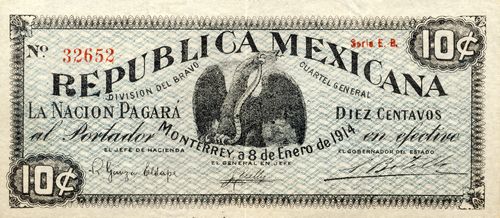
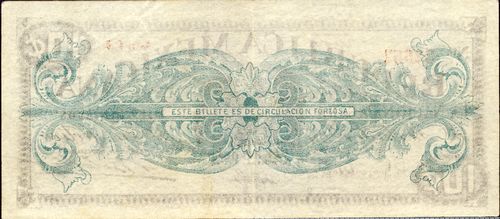 M3320 10c División del Bravo
M3320 10c División del Bravo
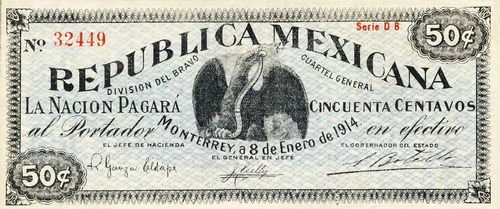
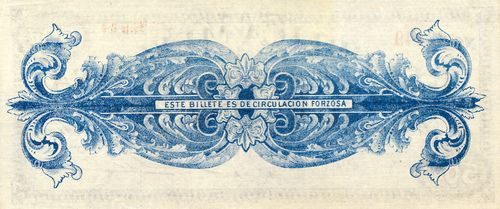 M3321 50c División del Bravo
M3321 50c División del Bravo
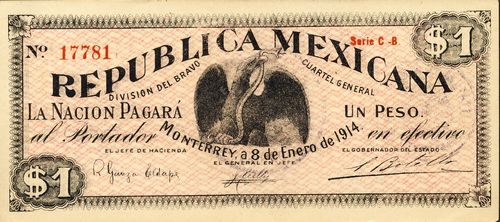
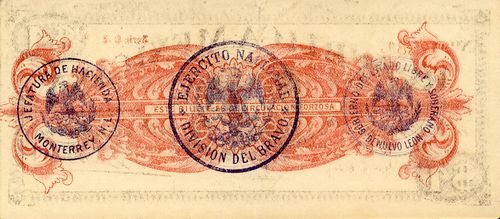 M3322 $1 División del Bravo
M3322 $1 División del Bravo
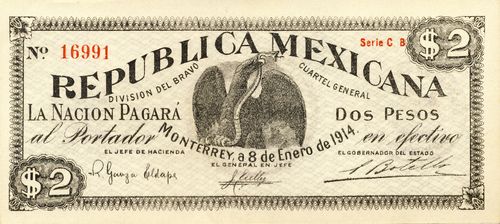
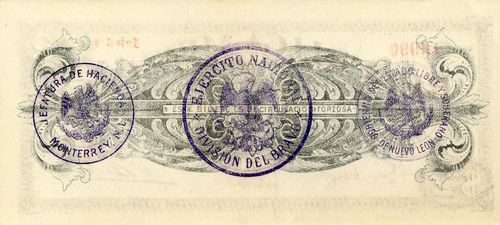 M3323 $2 División del Bravo
M3323 $2 División del Bravo
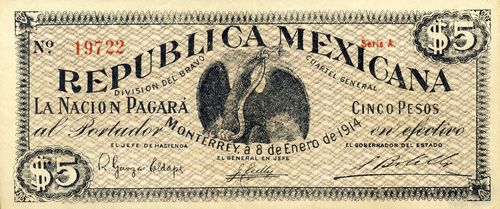
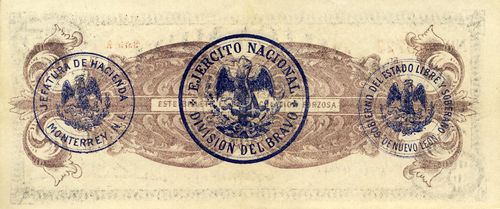 M3324 $5 División del Bravo
M3324 $5 División del Bravo
The five denominations (10c, 50c, $1, $2 and $5) are to a similar modest design, with the Mexican eagle, and though referencing the División del Bravo carry a statement that the Nation would pay. They have the printed signatures of Rodolfo Garza Aldape as Jefe de Hacienda, Téllez as General en Jefe, and Salomé Botello as governor and on the reverse have the seals of their respective authorities.
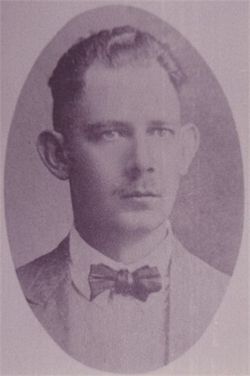 Rodolfo Garza Aldape was born in Múzquiz, Coahuila in 1889. Rodolfo Garza Aldape was born in Múzquiz, Coahuila in 1889. |
 |
|
He was General-in-Chief of the División del Bravo, stationed in northeastern Mexico, originally to attack Villa’s División del Norte in its rear as it progressed into central Mexico and, after the United States landing at Veracruz, to deter an invasion through Brownsville, Texas and Matamoros. Téllez was transferred to Guaymas in March 1914 and assumed duties as Provisional Governor of the State of Sonora and commander of the División del Yaqui. |
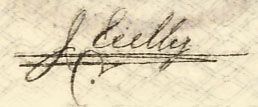 |
|
He was released in 1905 and returned to Monterrey, working as a lawyer advisor to companies, as a professor at the Civil College, where he taught the subject of ethics, and also as a professor at the School of State Jurisprudence. In 1909 he entered local politics and was elected deputy to the local Legislature and, two years later, served as a councillor in Monterrey. Following Huerta’s coup d’état, on 24 March 1913 Botello was imposed as governor of the state, replacing Jerónimo Treviño who “resigned”. During his year’s tenure, Monterrey suffered two attacks from the Carrancista forces as well as serious financial and food supply problems. On 24 April 1914 the Federal Army withdrew from Monterrey, and Botello went with it, accompanied by some members of his family and his cabinet. General Antonio I. Villarreal was appointed military commander and governor of Nuevo León, and Botello was made a brigadier general of the auxiliary cavalry. From Saltillo he went to the capital and on 10 July Huerta appointed him Secretary of Industry and Commerce. However, he soon left the country and settled in New York and then in San Antonio, Texas. During this time his assets were seized by the new government, though later returned. He retired from public life to serve as a business legal adviser and died in Monterrey on 2 August 1949 |
 |
On 5 January Garza Aldape had asked the printing firm of ‘El Modelo’ to produce 250,000 notes (50,000 of each denomination)ANL, Hacienda y Tesorería, caja 100. El Modelo was owned by the Madero family. About a month later, on 1 February, Téllez wrote to the firm authorizing a new issue of another 800,000 notes (200,000 of 10c, 300,000 of 50c, 200,000 of $1, 100,000 of $2) which would have the same series letter but an extra subseriesANL, Hacienda y Tesorería, caja 100. Armando Botello had been appointed Interventor to oversee the work and on 27 February reported that one million pesos in notes had been printed and sent to the Jefatura de Hacienda, in the following formatANL, Hacienda y Tesorería, caja 100:
| Series | from | to | total number |
total value |
|
| 10c | E | 00001 | 50000 | 50,000 | $ 5,000 |
| E-A | 00001 | 60000 | 60,000 | 6,000 | |
| E-B | 00001 | 60000 | 60,000 | 6,000 | |
| E-C | 00001 | 60000 | 60,000 | 6,000 | |
| E-D | 00001 | 20000 | 20,000 | 2,000 | |
| 50c | D | 00001 | 50000 | 50,000 | 25,000 |
| D-A | 00001 | 60000 | 60,000 | 30,000 | |
| D-B | 00001 | 60000 | 60,000 | 30,000 | |
| D-C | 00001 | 60000 | 60,000 | 30,000 | |
| D-D | 00001 | 60000 | 60,000 | 30,000 | |
| D-E | 00001 | 60000 | 60,000 | 30,000 | |
| $1 | C | 00001 | 50000 | 50,000 | 50,000 |
| C-A | 00001 | 60000 | 60,000 | 60,000 | |
| C-B | 00001 | 60000 | 60,000 | 60,000 | |
| C-C | 00001 | 60000 | 60,000 | 60,000 | |
| C-D | 00001 | 20000 | 20,000 | 20,000 | |
| $2 | B | 00001 | 50000 | 50,000 | 100,000 |
| B-A | 00001 | 60000 | 60,000 | 120,000 | |
| B-B | 00001 | 40000 | 40,000 | 80,000 | |
| $5 | A | 00001 | 50000 | 50,000 | 250,000 |
| $1,000,000 |
However, not all these combinations are known, and the $2 notes are known as C-A and C-B. On 27 February the printing plates were destroyedANL, Hacienda y Tesorería, caja 100.
The American consul general, Philip C. Hanna, reported that these issues were in general use in the capital, and used to pay all employees, include the railway workers, in Saltillo and Torreón as well as Monterrey. They were accepted by the banks in Monterrey, but in a separate account and only to be reimbursed in the same mediumSD papers, 812.515/16.
In late February The Mexican Herald reported governor Botello as claiming the vales a success. They were accepted everywhere and were as good as any other tender except for purposes of foreign trade. A good many vales had already been redeemed and destroyed and the whole issue would be redeemed with a few months if matters continued as at presentThe Mexican Herald, 19th Year, No. 6751, 25 February 1914.
Withdrawal
By March it was announced by the Secretaría de Gobernación that the notes were to be redeemed. All federals offices in the state were instructed to take up such of the vales as were presented for collection, with the federal government sending the necessary fundsThe Mexican Herald, 6 March 1914. The Minister of Gobernación, Ignacio Alcocer, wrote that “in order to appease the merchants of [Coahuila], the President (Gen. Victoriano Huerta) has authorized me to announce that they may deposit in any public office the amount of government vouchers in their possession so that a like amount of cash may be immediately made available to them”Periódico Oficial, Nuevo León, 10 March 1914. This did not actually take place because there was literally no cash available. On 17 March the Jefe de Hacienda, Rodolfo Garza Aldape, reported that his Jefatura would proceed to exchange the $5 vales, but those of 10c and 50c would remain in circulation until there was enough small changeEl Diario, 17 March 1914.
While the revolutionaries under Pancho Villa attacked down the centre of Mexico, Pablo González took the offensive in the northeast. On 18 April he began a frontal assault on Monterrey and after almost six days of incessant fighting the remnants of the defending force fled to the mountains of the south. On 6 May Pablo González nullified the Huertista issues of Coahuila, Nuevo León and Tamaulipas[text needed]. On 13 May the governor of Nuevo León, Antonio I. Villarreal, decreed that, as a humanitarian act, for three days dayworkers could change up to five pesos in División del Bravo notes for Constitutionalist notesEl Constitucionalista, Saltillo, 6 June 1914. On 16 May the Jefe de Hacienda in Monterrey, M. Amaya, changed $21,500 in these vales that Mayor José T. Cantú handed in for Constitutionalist notesCEHM, Fondo LXVIII-1 Manuscritos de General Manuel Willars González, carpeta, legajo 2271.
In June they were still accepted in San Luis Potosí. They are known with a violet oval stamp “ADMON. PRAL. DE RENTAS. SAN LUIS POTOSI”Antonio Kalixto Espinosa, Papel moneda de la Revolución Mexicana, que circulo en San Luis Potosí.
Many female camp-followers possessed this money and at the Secretaría de Guerra in Mexico City, General Velasco announced that the notes would be exchanged by the pagadores in the Divisions for legal tender, taking steps to avoid any exploitation by speculatorsEl País, Tomo I, Año XIV, Núm. 4631, 27 July 1914; El Imparcial, Tomo XXXVI, Núm. 1920, 27 July 1914.
On 13 August, in response to a request from the State Department, consul general Hanna sent a detailed report on this issue. He stated that from information received from persons in a position to know at least two million pesos was circulated in Monterrey and the immediate vicinity, but it seems that he was collating the Saltillo and Monterrey issues. This money continued to circulate until shortly after the federal army evacuated the city. One British company was left with $112,000, a German wholesale house with over $60,000 and other foreign houses with large amounts on their hands. When General González entered Monterrey, the question arose as to whether this scrip would cease to circulate or not. It was allowed to continue to circulate for about two weeks and then an order was given forbidding its circulation but the Constitutionalist authorities offered to redeem such money as was held by the poorer class in amounts up to five pesos. No provision was made for larger amounts of money belonging to business houses or the wealthy class of citizens. However, foreign business houses in Monterrey appeared to believe that a settlement would be made with them some time in the future and that the Mexican government would take steps to redeem such Téllez scrip as foreigners held. Mexicans on the other hand (more realistically) believed that any scrip that they held would never be redeemed.
In August 1914 after the Carranza government had acknowledged Huerta’s Obligaciones Provisionales there was obviously talk about the other Huertista issues as on 28 August subsecretario Felicitas Villarreal, declare that only the Obligaciones were accepted and the others that had circulated for a long time in Nuevo León and Coahuila had no valueEl Dictamen, Año XVI, Núm. 1259, 29 August 1914.
When the Constitutionalists had taken over the Tesorería General in Monterrey they found it contained $7,292.20AMMont, Acta of 25 April 1914. Of this amount $2,999.20 was in División del Bravo vales and these were incinerated on 27 October 1914ANL, Hacienda y Tesorería, Monterrey, caja 155.
Incidentally, Téllez had been transferred to Guaymas in Sonora in March 1914 and assumed the duties of Provisional Governor of the State and commander of the División del Yaqui. There he was responsible for another emergency “siege” issue.

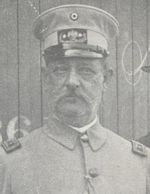 Joaquin C. Téllez was born in Mexico City in 1866 and entered the army as a Sargento 2o on 2 February 1881. He fought against the Yaquis and was at the peace talks celebrated on 15 May 1897. In 1910, as a Coronel, he commanded the 7o Regimiento in Chihuahua against the Maderistas and rose to Brigadier. Then in 1912 he fought the Orozquistas, commanded one of the Brigadas of the División del Norte and was made a General de Brigada.
Joaquin C. Téllez was born in Mexico City in 1866 and entered the army as a Sargento 2o on 2 February 1881. He fought against the Yaquis and was at the peace talks celebrated on 15 May 1897. In 1910, as a Coronel, he commanded the 7o Regimiento in Chihuahua against the Maderistas and rose to Brigadier. Then in 1912 he fought the Orozquistas, commanded one of the Brigadas of the División del Norte and was made a General de Brigada.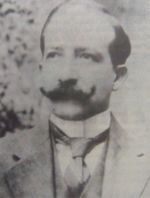 Salomé Botello Garza was born in Villaldama, Nuevo León, on 2 November 1875. He completed his law studies In Mexico City and in 1902 graduated as a lawyer. He devoted himself to journalism, especially in the newspaper La Protesta, where, in collaboration with Rodolfo Reyes, he published several articles in defense of Governor Bernardo Reyes and against the Díaz’ Secretary of Finance, José Yves Limantour, for which, in 1903, he was sent to the Belén prison, where he remained for two years.
Salomé Botello Garza was born in Villaldama, Nuevo León, on 2 November 1875. He completed his law studies In Mexico City and in 1902 graduated as a lawyer. He devoted himself to journalism, especially in the newspaper La Protesta, where, in collaboration with Rodolfo Reyes, he published several articles in defense of Governor Bernardo Reyes and against the Díaz’ Secretary of Finance, José Yves Limantour, for which, in 1903, he was sent to the Belén prison, where he remained for two years.